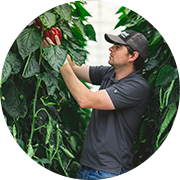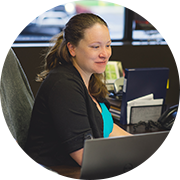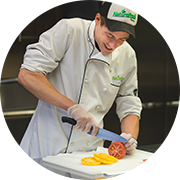Growing fresh produce using sustainable growing practices is a top priority at our farm.
Our team is always striving to be better when it comes to growing our plants and operating our business sustainably. Whether we are talking about energy conservation, supply chain efficiency, or eco-friendly office initiatives, our team works every day to be more responsible with our world’s most important resources.
We believe our Sustainability Team is made up of every person who works at NatureFresh™ – everyone has a role to play in keeping our business eco-friendly!
The Grow-To People: A Sustainable Team
We have so many integral members of our team who play key roles when it comes to keeping NatureFresh™ greenhouses and operations as eco-friendly as possible – they are the Grow-To People who are working towards a more sustainable future for our industry.
Meet Herman F., Carly W., and Zach L. – three members of our team who are passionate about keeping NatureFresh™ Farms as environmentally responsible as possible.

Herman F.
Grower

Carly W.
Logistics

Zach L.
On-Site Chef
Asking Our Experts: The Road to Sustainable Growth
We sat down with Herman, Carly, and Zach to learn how they help make operations at NatureFresh™ as sustainable as possible and why it’s important to them. They answered questions about sustainable growing practices in our industry, as well as questions about how they strive to be eco-friendly both at work and home!
Keep reading to find out more about greenhouse sustainability and how we’re making a difference at NatureFresh™ — straight from our experts.
How is NatureFresh™ Farms facing challenges when it comes to making their greenhouses more sustainable?
Herman: “When it comes to energy creation and conservation, we are constantly trying to implement new and better technology to make our greenhouses more efficient. One tool we use is energy screens – they reduce energy usage by conserving heat in our greenhouses and keeping our plants shaded from the sun. Our energy screens allow us to use approximately 47% less energy to heat our greenhouses!
Carly: “As a member of the Logistics team, I work with my team every day to try and overcome the challenge of reducing food miles for our products, both for the benefit of consumers and the environment. We combine as many orders of produce onto the least amount of trucks possible – this requires a huge amount of coordination between our farms, the Sales office, and Shipping and Receiving, but it’s worth it. By coordinating these orders, we can reduce the number of trucks on the road and the amount of time it takes for consumers to get fresh produce!”
Zach: “My team doesn’t work directly in the greenhouse, but we work together to feed the people who do! We don’t just talk the talk when it comes to eating healthy – we help make sure our team walks the walk, as well. When we’re cooking in our on-site kitchen, we do our best to cross-utilize ingredients so no food goes to waste. We are also lucky to be able to use our own Bell Peppers, Tomatoes, and Cucumbers for our lunch program, so we make sure to only take enough produce to feed our team!”

“Our energy screens allow us to use approximately 47% less energy to heat our greenhouses.”
– Herman
What are some of the positive impacts that greenhouse growing can have on the environment?
Herman: “Since we are a larger operation, we have the resources to group our delivery trucks and reduce our products’ food miles. We also have the ability to strategically build our greenhouses in areas where we can service a large population, which also helps with reducing food miles.”
Carly: “Growing in a greenhouse means you can use good bugs to fight bugs instead of relying solely on pesticides. You can’t use an Integrated Pest Management (IPM) system outside because the bugs will likely just fly away! Since we grow in a contained environment, bugs are an excellent tool to keep our crops strong and healthy.”
Zach: “Since we grow in a controlled environment, we have less food waste than you may see in a field setting. This is because none of our products are affected negatively by wind, rain, or larger pests like birds or squirrels – they are grown in an environment that is designed to be perfect for their development! This means our plants grow stronger and that less of the fruits that they bear are of poor quality.”

“Growing in a greenhouse means you can use good bugs to fight bugs instead of relying solely on pesticides.”
– Carly
What is the most interesting or exciting thing that NatureFresh™ Farms does to make its greenhouse growing practices as sustainable as possible?
Herman: “Our irrigation system is pretty impressive – we clean and reuse all of our excess nutrient water to ensure we don’t abuse this important resource. With a closed-loop irrigation system, we use far less water than we would have to use if we were field farmers.”
Carly: “We do a lot of exciting things to keep our growing practices as sustainable as possible. We use recycled coconut husks as a natural growing medium, and we recycle all our excess nutrient water. But one of my favorite things that NatureFresh™ does is run the Greenhouse Education Center program. Our mobile greenhouse showcases our sustainable growing practices for people all over North America to see, so not only does NatureFresh™ grow sustainably, we also share that information with people everywhere!”
Zach: “I found it pretty fascinating when I learned about our biomass boilers. These boilers burn clean wood that may have ended up in a landfill if we didn’t use it for energy creation – that’s amazing! It reminds me of the role of our kitchen staff in a way – if we didn’t use up all of the food we use to cook, a lot of it could go to waste and not be used productively.”

“Our boilers burn clean wood that may have ended up in a landfill if we didn’t use it for energy creation – that’s amazing!”
– Zach
What is one thing that everyone can do to help make a more positive impact on our environment?
Herman: “One thing that I try to do and encourage others to do is buy local whenever possible. It always feels good to support local growers, and it is better for the environment to buy local because the food you are buying has travelled less miles to get to the store (causing less carbon emissions).”
Carly: “I am a big supporter of switching from printing paper to sharing documents online – sending emails, editing PDF documents on my computer, and using ERP (Enterprise Resource Planning) software tools to coordinate with people instead of printing off dozens of forms – these are all things I do at my job and even at home to reduce my paper usage!”
Zach: “When grocery shopping, we have a few basic rules. For one, we always try to buy items that are in-season so it didn’t have to travel a long way to get to the store. We are also very conscious of only buying what we need – we try to be realistic about quantity and storage options. Finally, we try our best to buy food with minimal packaging!”
Interested in learning more about how we grow green? Check out our Sustainable Growing page!
Find even more ways you can help make a difference and protect the environment with these tips to go green in your kitchen.



